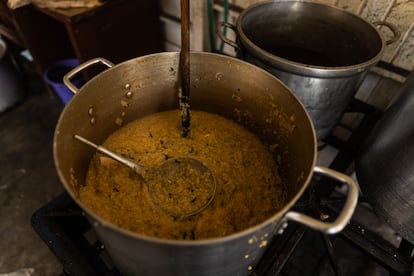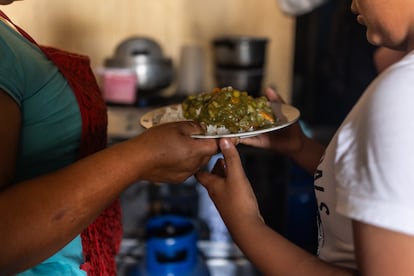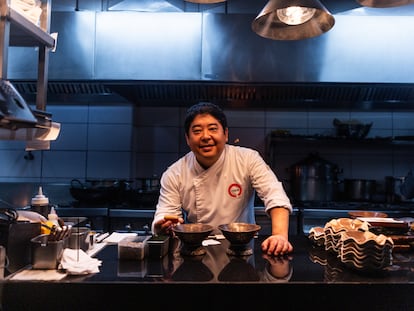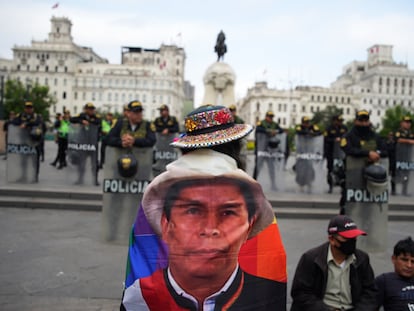Peru: A culinary hotspot with widespread hunger
The number of people without food or adequate nutrition is increasing alarmingly in this Latin American nation known for its cuisine
“I was leaving here with some food for my family, and this woman comes up and asks me if I could spare something to eat,” said Vilma Solier, a 39-year-old mother who works at the Nueva Esperanza communal kitchen in Lima’s San Juan de Lurigancho district, one of the most densely populated areas of the country. “I gave her part of what I was taking home.” Inside the small wooden building, Carmen Rosa Méndez serves two young street vendors who sell notebooks under the scorching sun. Three large pots sit on a stove, surrounded by ladles, a small table and a few chairs.
It may be hard to believe, but in this country known for its cuisine, many people are going hungry. Not just food scarcity, but actual hunger. According to a 2023 survey by the Institute of Peruvian Studies (IEP), 57% of those interviewed (1,210) reported that their households had run out of food at least once in the last three months. In urban Peru, the percentage is 56%, while in rural Peru it’s even higher — an alarming 75%. This reveals the notable gap between rural and urban areas, as well as social divisions within cities. It’s also 75% in some urban areas where communal kitchens are often located.

“In these areas,” said former Minister of Development and Social Inclusion (MIDIS) Carolina Trivellí, “only 4% of the population has an adequate level of food consumption.” Trivelli says the situation is serious, and she doesn’t understand why hunger is not considered a huge problem. “It’s not that there is no food, but people don’t have the means to get it,” she said.
There are days when Solier doesn’t have anything to cook at her communal kitchen. “Especially when there is no water,” said Solier as she served Bruno Cabrera. He’s a 62-year-old man who walks with a limp due to a birth defect. “I was born like this and I have never been to a hospital in my life,” he said. He’s one of the 17 “social cases” at the communal kitchen who receives food for free.
Today’s menu features a hearty quinoa stew with rice and chicken. It costs three soles ($0.78) and is almost sold out by the early afternoon. The 60 diners at the communal kitchen have eaten their lunch and taken their rations home. “We won’t refuse food to anyone who asks, no matter who they are,” said Solier.
Solier and other volunteers cook the food and pay a lower price ($0.52) for their efforts. Every day, they work hard to “fill the pot.” They go to markets and buy whatever they can with the communal kitchen’s meager profits, and collect perishables that are about to be thrown away. They always make sure to use every little scrap.

IEP surveys from previous years indicate that food insecurity is worsening in Peru. In 2012, 17% of survey respondents reported not having food at least once in the past three months. However, this number rose to 57% in September 2023. Several factors contributed to this deterioration, especially the pandemic. In 2020, many communal kitchens like Nueva Esperanza and Víctor Marcial in Pamplona Alta (one of Lima’s poorest areas) were set up during the quarantine.
The Víctor Marcial communal kitchen is led by Rossana Huamán Colque, and sits on top of a hill beyond the paved road. Water is delivered by a tanker truck every day. It serves 104 people, has 20 social cases and charges four soles ($1.03). Today’s menu is quinoa soup and green chicken stew. Hunger is rampant around here and many families have dramatic stories to tell.
Francisca Guzmán is a member of the Víctor Marcial communal kitchen and has eight mouths to feed. Her husband used to beat her until she forced him to leave six years ago. Now she lives with her four children and four relatives in a small, three-bedroom house. She goes to the communal kitchen every day to volunteer and bring food home. Some days, they only eat fried eggs and rice.

Guzmán has never been to one of Lima’s many grilled chicken eateries, which is something even the poorest Peruvians can afford. She cooks at Víctor Marcial every weekday, and on weekends, she does laundry or cleans houses in wealthy areas of Lima. Guzmán rarely takes a break, but never complains – she just works hard and perseveres.
She and her family are among the 70% of people who reported food insecurity in the IEP survey. Women and children are the most affected. In Latin America, there is an 11.3% disparity in food security between men and women, according to the Ayuda en Acción organization.
Dramatic numbers
In 2022, the U.N. Food and Agriculture Organization (FAO) reported that Peru had the highest food insecurity in South America. This crisis was aggravated factors like the pandemic, the war in Ukraine (causing a fertilizer shortage), and the Yaku cyclone that damaged crops in 2023. Government neglect is another contributing factor, while Peru’s global culinary renown has garnered more attention than the hunger experienced by much of the country’s population.
Trivelli believes that there should be a special, high-level government entity led by an official empowered to address this crisis. The alarming figures speak for themselves. The Global Hunger Index (GHI) report from 2023 highlighted the plight of 16 million Peruvians suffering from nutritional deficiencies. Shockingly, this has led to a soaring 43.6% anemia rate among children aged 8 to 35 months.

Sociologist Fernando Eguren noted another concern apart from the children: other vulnerable groups such as prisoners, the elderly, sick people living in poverty, and even foreign migrants who often resort to begging for food on the streets of Lima. Then there’s the significant impact of climate change, which is severely affecting agriculture, especially family farms that produce around 60% of Peru’s food. This global phenomenon affects potato and other food production, as well as ocean fishing and the Amazon Basin’s natural resources. According to a forthcoming paper by Eguren, shrinking Andean glaciers are affecting lakes, rivers and small mountain ponds. Droughts in 2023 led to Puno’s (southern Peru) driest year in the past 59 years. All these factors have impacts on food security.
Communal kitchens don’t give up
The 3,500 communal kitchens in Peru (most of them in Lima) fight every day to put food on the table. Nueva Esperanza’s president, Abilia Ramos, said that the members cover 75% of the communal kitchen’s operating costs, with the rest coming from MIDIS and the municipality of Lima. During the pandemic, they put up signs in markets asking for donations. Now they raise funds by selling desserts, beverages and roast chicken. “We’re actually solving the problem for the government, and they don’t even realize it,” she said. She struggles every day on this dusty hill at the end of a steep street to make sure the poorest of the poor don’t go hungry. When asked about Peru’s culinary fame, she simply said, “I’m proud, but there are other things going on here.”
Sign up for our weekly newsletter to get more English-language news coverage from EL PAÍS USA Edition
Tu suscripción se está usando en otro dispositivo
¿Quieres añadir otro usuario a tu suscripción?
Si continúas leyendo en este dispositivo, no se podrá leer en el otro.
FlechaTu suscripción se está usando en otro dispositivo y solo puedes acceder a EL PAÍS desde un dispositivo a la vez.
Si quieres compartir tu cuenta, cambia tu suscripción a la modalidad Premium, así podrás añadir otro usuario. Cada uno accederá con su propia cuenta de email, lo que os permitirá personalizar vuestra experiencia en EL PAÍS.
¿Tienes una suscripción de empresa? Accede aquí para contratar más cuentas.
En el caso de no saber quién está usando tu cuenta, te recomendamos cambiar tu contraseña aquí.
Si decides continuar compartiendo tu cuenta, este mensaje se mostrará en tu dispositivo y en el de la otra persona que está usando tu cuenta de forma indefinida, afectando a tu experiencia de lectura. Puedes consultar aquí los términos y condiciones de la suscripción digital.










































